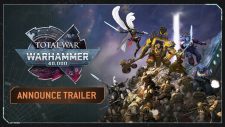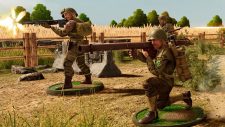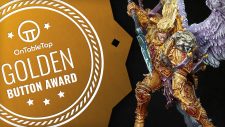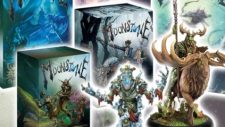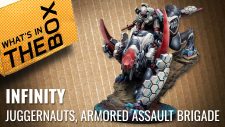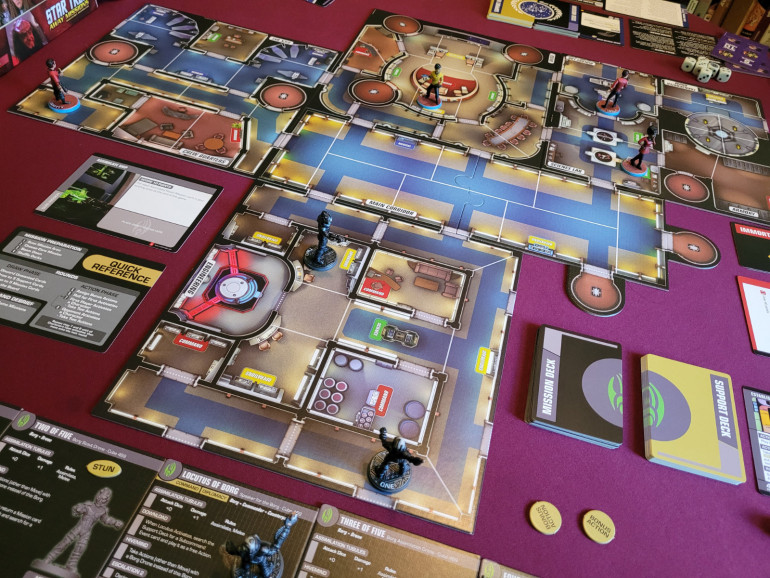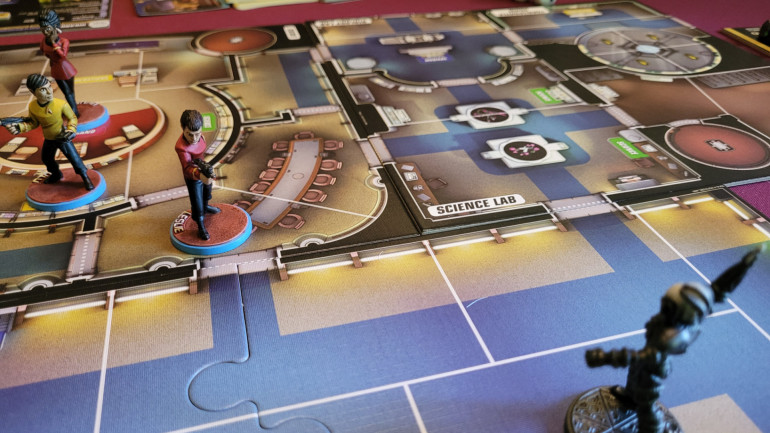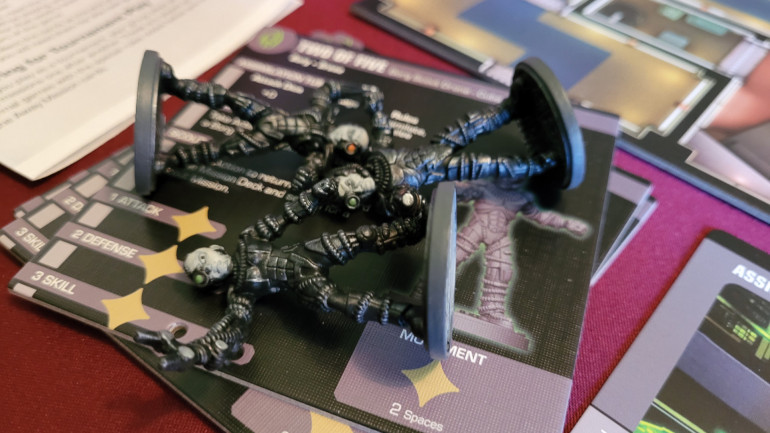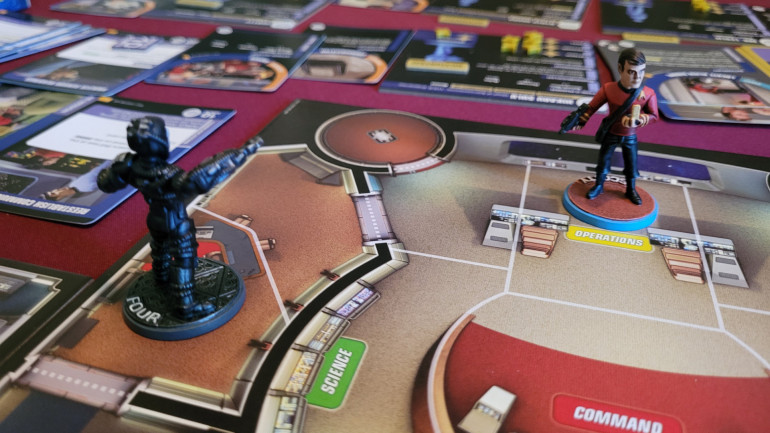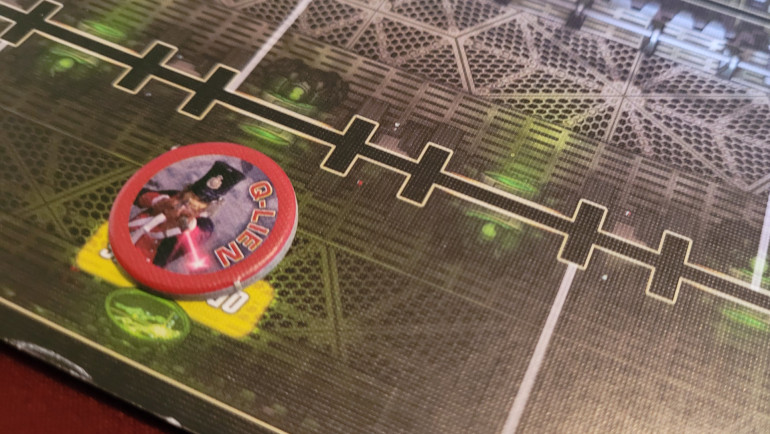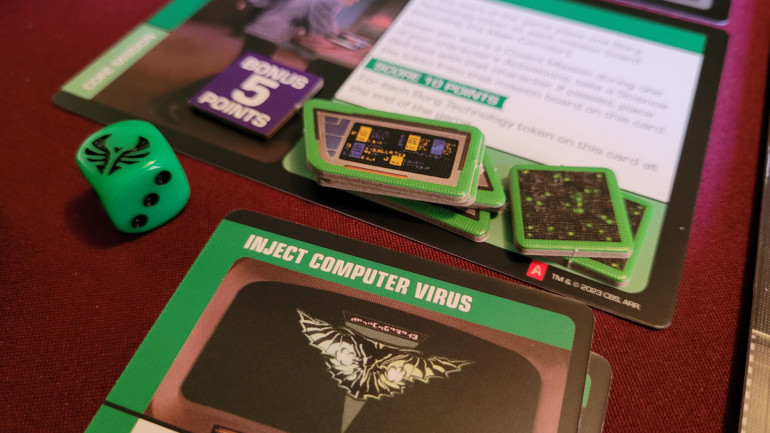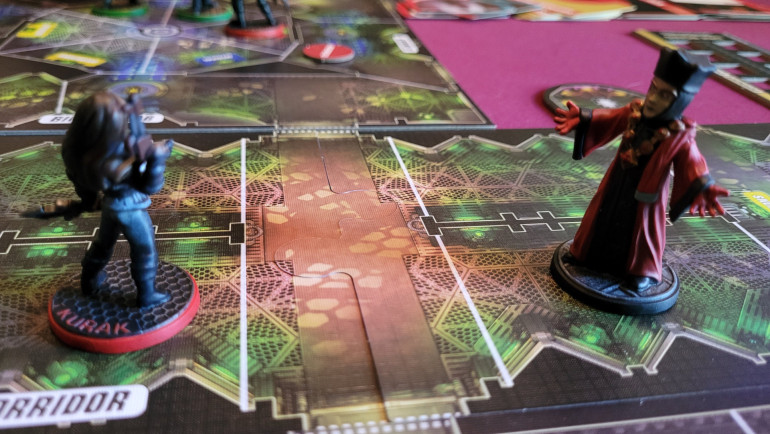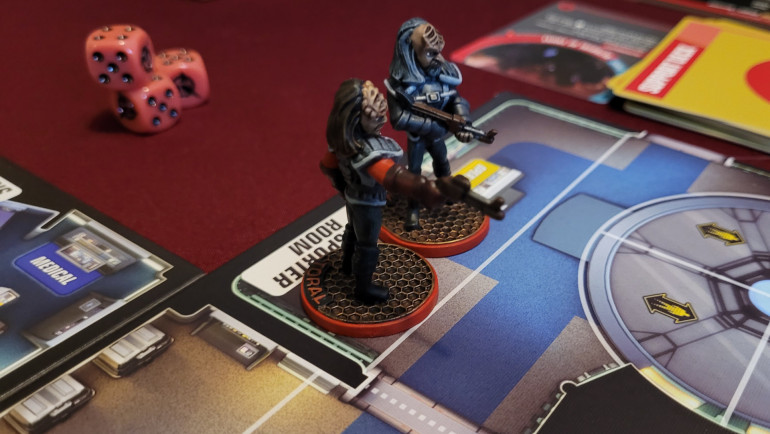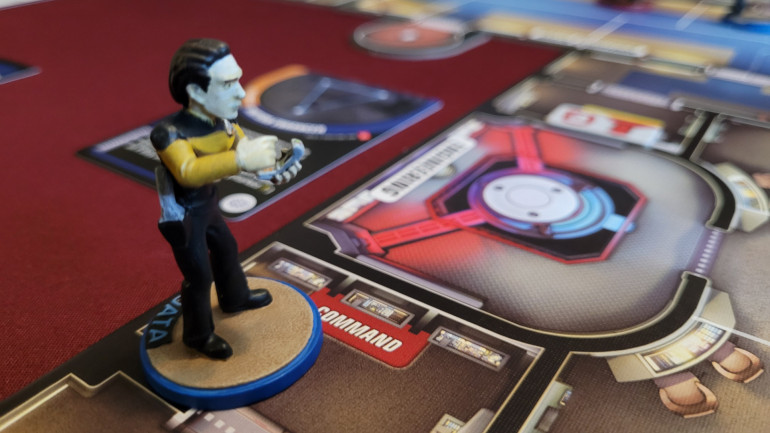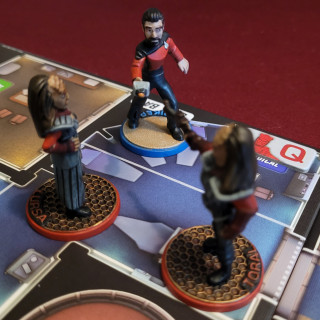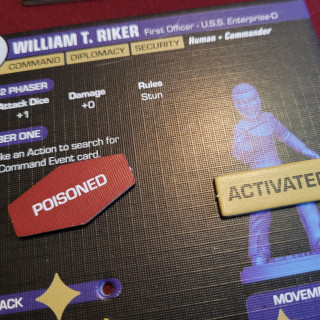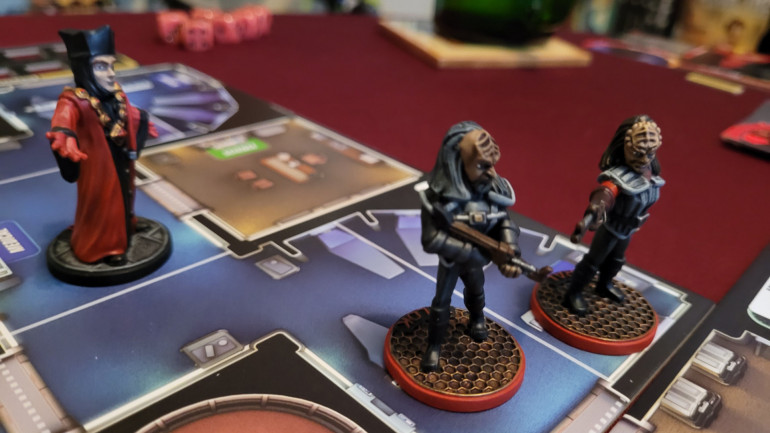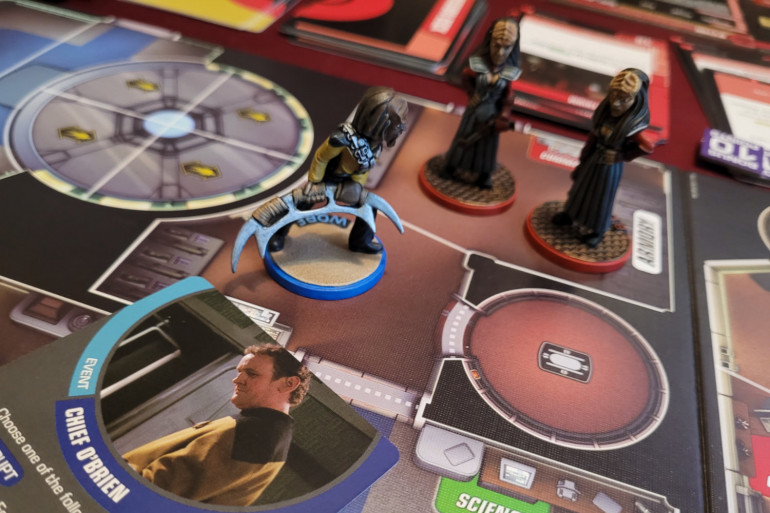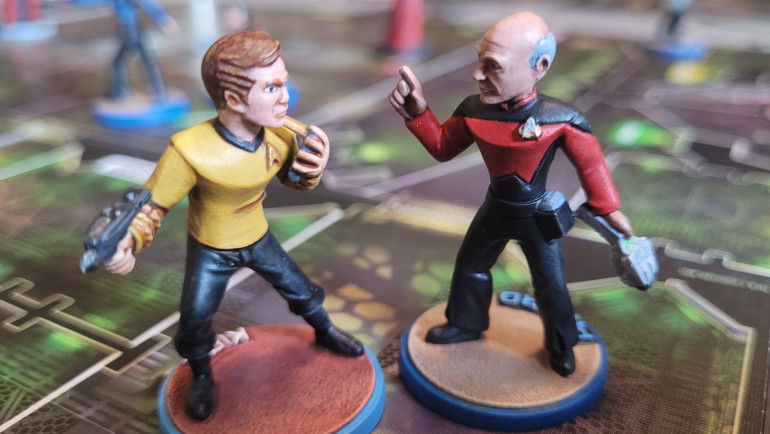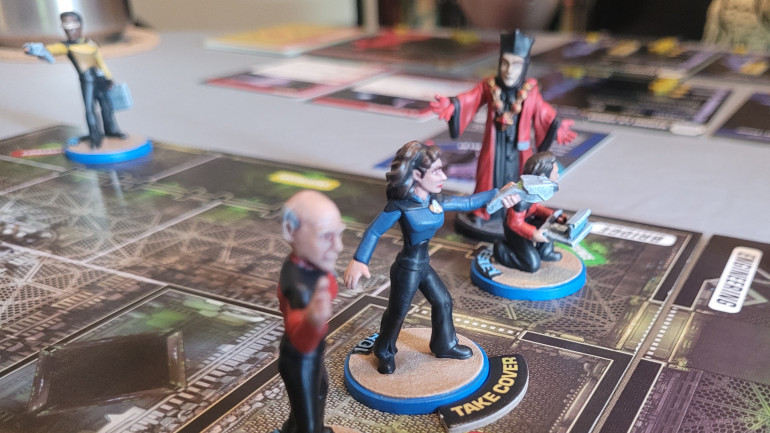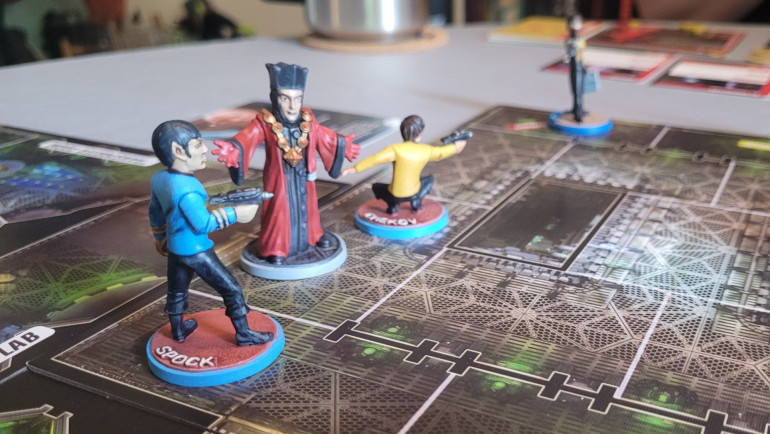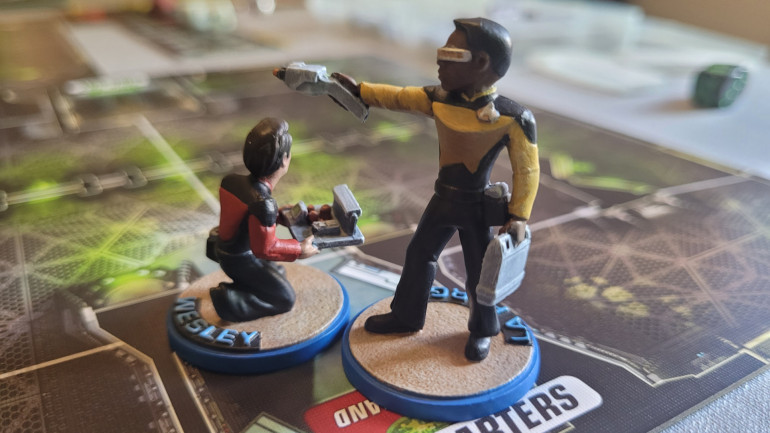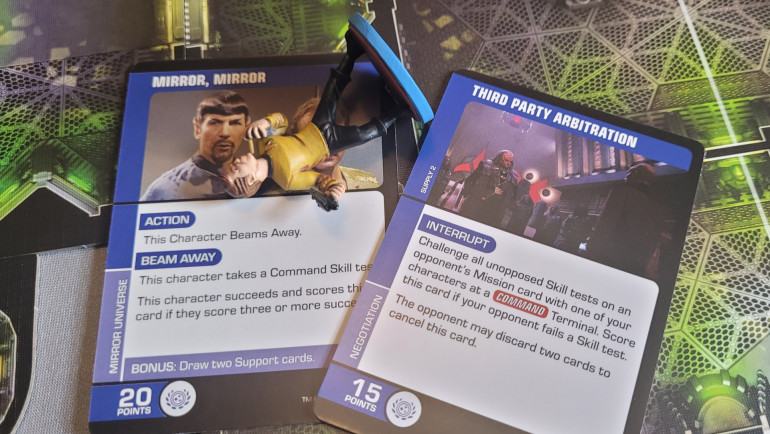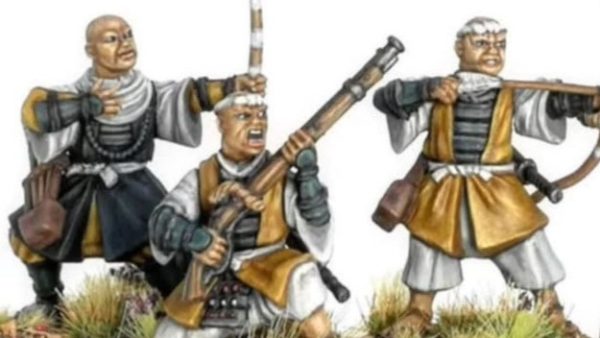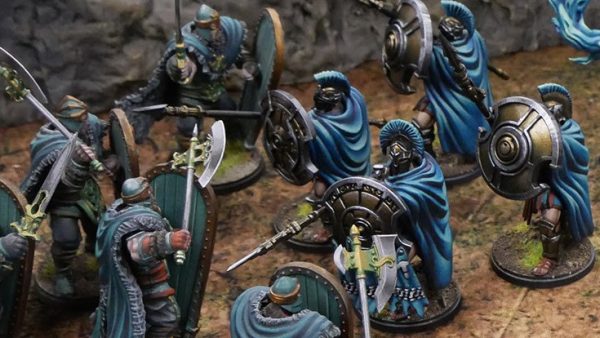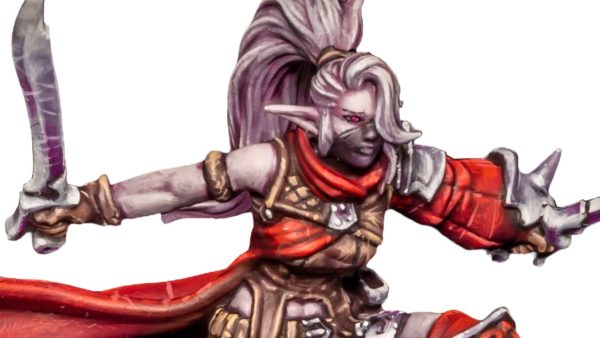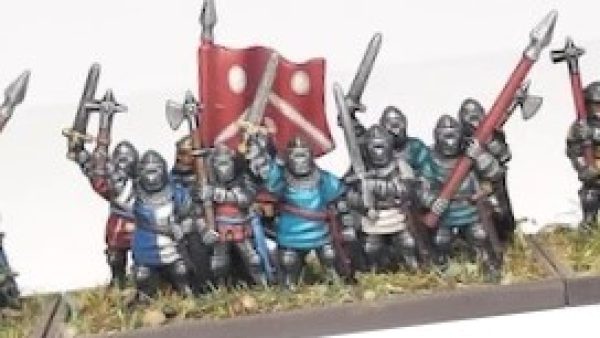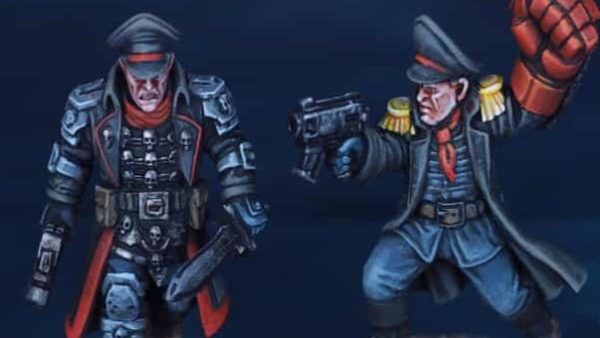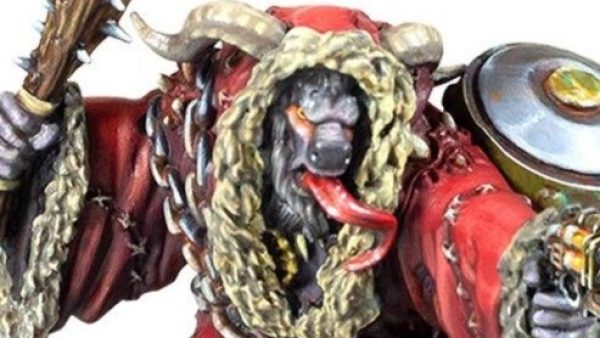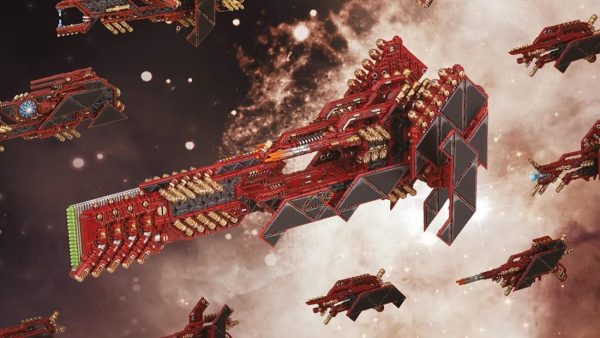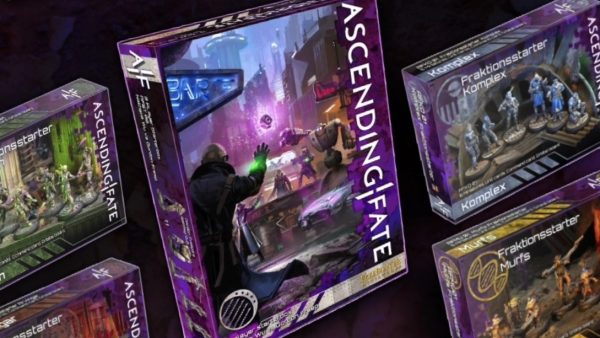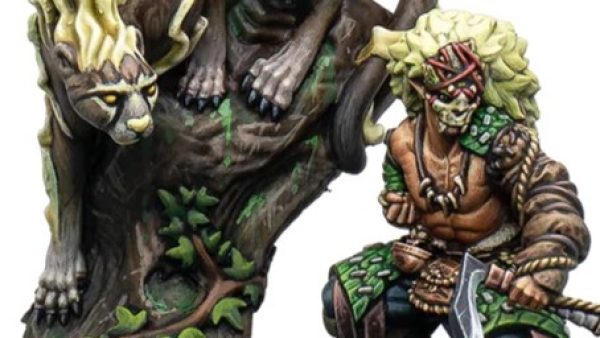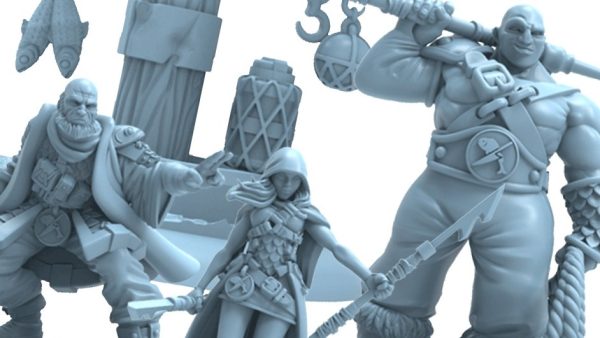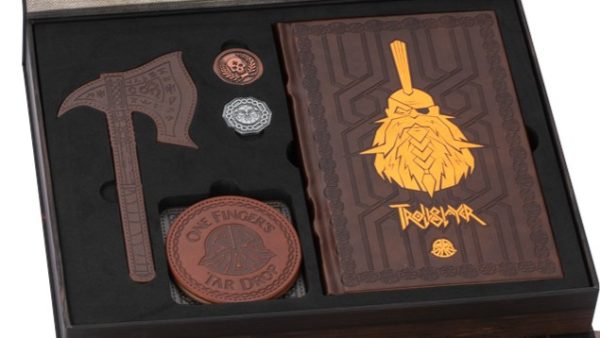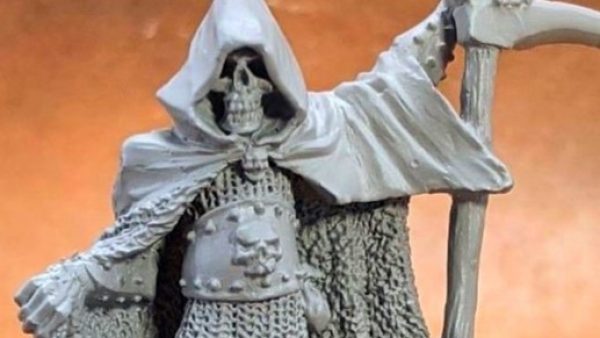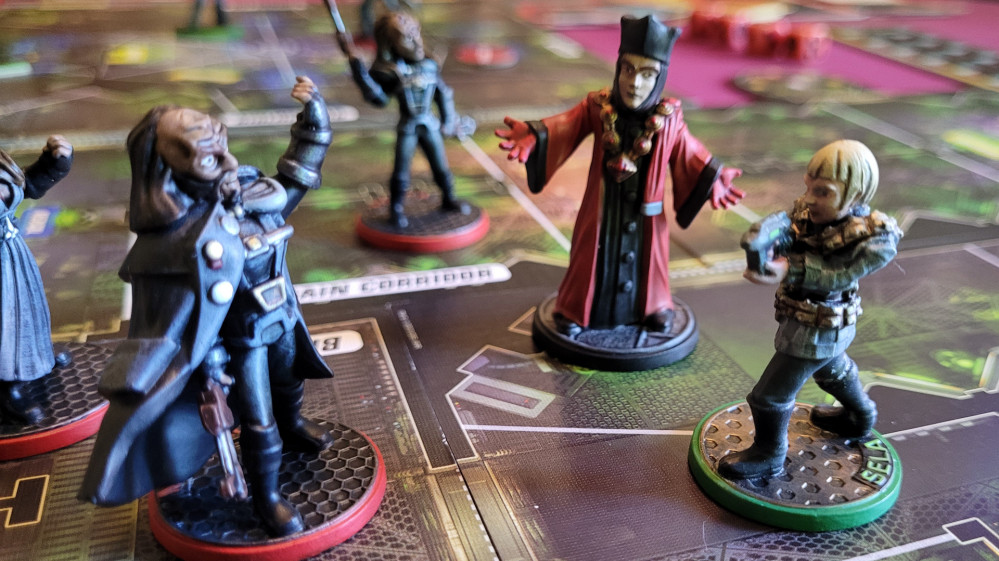
Star Trek Away Missions – the Q Campaign
Recommendations: 6
About the Project
I was able to get my hands on enough material from the Q Organized Play kit for two players so my wife and I could play it at home. The material is meant for a four-game series, so since there are currently eight different away teams in the game, this will also be a good opportunity to try out all the different characters.
Related Game: Star Trek: Away Missions
Related Company: Gale Force Nine
Related Genre: Science Fiction
This Project is Completed
Game 1: Just Playing With Q
The first game follows the normal setup and rules, with Q adding a bit of chaos in the form of a random Immortal Q card drawn at the beginning of each round. Additionally, at the end of the game each player rolls a die and consults a chart that will adjust their score either up or down depending entirely on chance. That’s Q for you…
We’ve decided to choose our first match-up randomly from the available away teams, with one exception: we’re saving Kirk vs Picard for last, so we can finally settle that question once and for all. Our first game will be me playing Locutus and the Borg vs. my opponent playing Scotty’s team, which includes Sulu, Uhura and the ubiquitous Mr. Leslie.
Our Immortal Q card for round 1 is Mis-Q, which allows each player to place an opponent’s character in any empty space on the board, then pick a different opposing character to start the round with a Stun token (which takes one of that character’s two actions for the turn to remove). Additionally, each player has to discard a random mission card, so if either of us was placing our characters with a particular mission in mind, those plans might go up in smoke. It’s possibly not the most interesting card to draw for the first round of the game, since we won’t really have been working towards any particular goals yet. On top of that, the Borg start with only two of their six characters on the board, with the rest showing up on rounds 2 and 3.
From here it’s a normal game of Away Missions. Gerry and Justin did a good Let’s Play for the game, but in short: players take turns activating characters one at a time. Each character can do two actions: move, attack, take cover, or a special action, usually related to solving a mission. Missions are how you get points, with most of them involving going to a certain type of terminal space on the board and then passing a skill test.
In this case, our game highlights the strength of the Federation faction and the weaknesses of the Borg. The Borg are incredibly slow; their movement rate is only two (as opposed to every other character’s 4), and as mentioned above they start the game with only two characters in play. The game does make up for this with Bonus Action tokens — at the beginning of each round, the player with fewer characters on the board gets Bonus Action tokens equal to the difference. Each Bonus Action can be spent to give any one of your characters an extra action, even if they’ve already taken their turn this round. But they can’t be saved up between rounds, so it’s use them or lose them.
Normally Away Missions is focused on mission solving rather than combat, especially for the Federation, but my opponent has decided to demonstrate the difference between the cowboys of the original series and the diplomats of the Next Generation by coming out guns blazing. Sulu and Leslie quickly move into action and take out one of my Borg drones. It’s especially tragic as this drone had been outfitted with an equipment card that makes Engineering tests easier, and the mission I was going for is an Engineering mission.
The rest of the game unfolds in a similar fashion. Our round two Immortal Q card changes all the terminal types, making us scramble to get where we need to be to solve our missions. I get to add two more Borg to the board, but my opponent is using her away team extremely well; Scotty and Uhura are hiding out on the bridge solving missions, while Sulu and Leslie are on the offensive, picking off my Borg drones one by one.
At the start of round 3 (games of Away Missions only go for three rounds), our Immortal Q card lets us each recover a damage from one of our characters, plus we each get two Bonus Action tokens. I get to drop two more Borg Drones in, so I decide to go on the offensive myself in what will turn out to be a vain attempt to assimiliate the bridge, a “go somewhere and pass a test” mission that requires 5 total successes over multiple actions and/or turns. Along the way I take a swipe at Scotty, since if I can deal him enough damage he’ll be assimilated as a drone, and provide me with another character to use. No luck though, Scotty manages to elude my grasp.
The game ends in crushing defeat for the Borg. We both roll a “1” on the score adjustment chart, which forces each of us to discard our highest-scoring mission. This leaves us with a final score of 65 for my opponent’s Federation and a paltry 15 for my Borg. In this case I don’t think the wrinkles provided by Q had all that much effect on the game, other than a somewhat arbitrary change to the score at the end that couldn’t really be planned for.
Game 2: Q-liens
This game looks like it will have a little more going on in terms of Q interfering with the game. Each player gets 3 tokens representing Q-liens, Q’s clockwork soldiers who will activate like characters during the game, moving, making attacks, and blocking spaces to make movement around the board a little more tricky. As an added incentive to make use of our Q-liens, each time one of them deals damage to a character (they can’t attack each other), that Q-lien’s player gains 5 bonus points. In addition, we’ve got a different set of Immortal Q cards that will be randomly drawn at the start of each round. The Q miniature will be placed on the board, with the cards having various effects depending on where Q is positioned and who is in his line of sight.
For this game I’ll be using the Romulans led by Sela vs my opponent’s Klingons under the leadership of Gowron. The game allows for very minor swap-outs of characters, but we’re just using each team right out of the box. The card decks that each player uses can be customized as well, with each set providing a stack of extra cards, but again we’re using the suggested starting cards since we haven’t really played the game enough to know what cards will be better to use.
For our first round we draw Hide & Q, which gives characters in Q’s line of sight an extra die for attacks, but one fewer for skill tests. This will greatly assist the Klingons, since most of their missions involve attacking. Luckily I’m the first player this round, so I can place Q back in a corner where hopefully he won’t give my opponent too much of an advantage.
This game goes much better for me that the previous one. The Romulans are a lot better at accomplishing missions, even with my opponent’s Klingons shooting at me. I am able to creep around the Engineering section of the board and knock out several missions, then use the Q-liens to get in my opponent’s way, forcing her to spend actions attacking the tokens rather than my loyal Romulan forces. She does, however, manage to wound Taibak, one of my better mission solvers, pretty early on. Damage in this game is tracked by reducing the character’s stats, so for example when Taibak takes 2 damage I have to reduce his movement and his skill (used for mission solving) by 1. No stat can go below 1, and once all four stats are down to 1 the character is neutralized.
Our Immortal Q card for round 2 is Q’s Peace, the reverse of the card from the previous round. This time, attacks in Q’s line of sight are at a disadvantage, and skill rolls are at an advantage. I get to place the Q miniature again, and this time I put him right in the cental corridor where he can see most of the action. It has become clear that my opponent’s missions are all about attacking, so Q should do nothing but help me and hinder her. Any player can use one of a character’s actions to attempt to move Q to a different space on the board, but it’s a slight risk: that player rolls a die, on a 4 or better they can move Q, but on a 1 their oppoent gets to move him.
I manage to get some more missions done, and collect some intel tokens from the board. These are unique to the Romulan faction and will give me bonus points at the end of the game. Meanwhile, the Klingons are whittling down my forces — I haven’t lost anyone yet, but the damage is making all my characters less effective. However, my opponent doesn’t appear to be scoring many missions, and I am way ahead on points.
For the final round we draw Q-Pid for our Immortal Q card, which interferes with one of the game’s more interesting concepts: backup. Under normal circumstances, if you have two friendly characters in the same space on the board, they give each other backup, adding one extra die to each other’s attack, defense and skill rolls. My opponent used it to great effect in our previous game, with Sulu and Leslie tag-teaming my Borg drones. Now, however, it’s as if Q saw what she was doing and wants to put a stop to it. The Q-Pid card makes it so that any character with backup rolls two fewer dice instead of one extra, so we have to be careful about placing our characters and make sure to spread out as much as possible.
I’m at a bit of a loss for what to do on the final round. I’ve drawn two Assassination missions, which score if I take out one of my opponent’s characters, no easy feat as the Klingons tend to have high defense values. The other doable mission I have requires me to get two of my characters to terminals in Sickbay, clear on the other side of the board. To make matters worse, in order to get my characters there they will have to cross the main corridor, which is swarming with trigger happy Klingons.
Gowron has taken a little damage so I single him out as my assassination target, softening him up with the Q-liens before sending Sela herself in for the kill. Unfortunately I wasn’t quite able to make it happen, but I did get the two Romulan technicians over to sickbay to score a 30 point mission. The game ends with 140 points for the Romulans and 70 for the Klingons. This time around, the Q elements had a much more interesting impact on the game — moving and attacking with the Q-liens was an important part of both of our strategies, and making use of the Q miniature’s position was pretty critical.
Game 3: Deja-Q
We’re saving Kirk vs Picard for the grand finale, so that leaves us with Riker’s away team (consisting of Data, Worf and Lt. Shelby) to square off against the treacherous Sisters of Duras and their band of nefarious Klingons.
The scenario rules are similar to the previous game: at the start of each round, we draw a random Immortal Q card which will throw a spanner into the works. This time we’re shuffling together the cards from the previous two games, but unfortunately, upon looking at my notes I’ve realized that for game 3 we got the exact same cards that we had in game 2, in a slightly different order. As we won’t be using the Immortal Q deck in game 4, that means there are two cards we haven’t been able to play with, but I don’t see why any of these Q scenarios couldn’t be played as standalone games, perhaps just using Q and the Immortal Q deck and leaving out the Q-liens from scenario 2 or the Q Terminals from this scenario.
That brings us to the other element of this scenario. At the beginning of the game, each player is instructed to place a Q Terminal token on a terminal (the spots on the board where skill tests for missions are generally done) in their opponent’s starting area. As an action, a character can make a skill test at a Q Terminal — if passed, that player scores 20 points, and pass or fail, the player must roll on a random chart to see what weird effect happens. It can be anything from the character getting turned into a dog (losing all keywords and skill specializations, but otherwise able to act normally), taking damage, or immediately scoring a random mission. This is my favorite Q game element so far, it introduces some chaos to the game but it’s voluntary chaos, the player has to choose to activate the terminal.
I’ll be playing Riker’s team for this game. As we play the first round I’m noticing that the deck for this away team is weighted heavily towards playing against the Borg (this is the team that comes with the Borg in the two-player starter set), but there are also a lot of relatively easy high-scoring missions. Data is a mission-scoring machine — not only does he have a high Skill value and a lot of useful specializations, but he has a special ability that allows him to add more dice when supporting an ally character on a skill test.
I suspect that the Sisters of Duras operate similarly to the Romulans I played in game 2, so I’m determined not to let them skulk about unimpeded. While I have Data, Riker and Shelby focus on scoring missions, I send Worf out to pick a fight with the Klingons. His attack doesn’t inflict that much damage, but it does force my opponent to have two of her characters spend the round fighting with Worf instead of scoring missions, which will be good as long as the Duras Sisters don’t have a lot of combat-focused missions like the Gowron away team did in game 2.
At the end of round 1, the Federation has a huge lead over the Klingons, 130 points to 55. For round 2 I’ve drawn a huge 40 point mission that requires me to have characters stationed at different points on the board, but no actual skill tests, so I spend most of the round moving everyone into position. Worf has taken some major damage fighting off the Klingons, so I have him limp onto the bridge to help Data with some minor missions while Riker slips past the Klingons into the Medical bay. Unfortunately, he gets stabbed by a poisoned dagger in the process.
Hey Riker, watch out for those Kli… too late, you appear to have been poisoned. Hopefully there’s an antidote… (there was not)
The third and final round begins with Riker cornered in the Medical bay. Luckily the Immortal Q card for this round is Hide & Q, which reduces the number of dice for attack rolls in Q’s line of sight, and I am able to place him where he can see Riker’s assailants. I am hoping I can get Riker some medical attention before he expires — the poisoned dagger means he’ll lose his last hit point as soon as he activates. Alas, the Klingons manage to finish him off before I get a chance to do anything with him.
I don’t have many missions that I can score easily this round, so I’m in a bit of a holding pattern. I do have the Chief O’Brien card, which allows be to beam Worf into the path of the Duras sisters in hopes that they’ll have to spend their actions fighting with him instead of scoring.
The game ends with a bit of a whimper, but my opponent managed to catch up thanks to her core mission, Arms Deal, which gives her extra points for equipment cards she’s managed to squirrel away. The game still ends with the Federation winning, but the score is a very respectable 215 to 195.
Game 4: Ex-Q-s Me
It’s time for the main event: Kirk vs. Picard. For this final game, both players get to add a Mortal Q to our away teams. Q has 1 Attack, 2 Defense, 3 Skill, 4 Movement, and every skill specialization. Coupled with his base skill of 3, he’ll get a minimum of 4 dice on any skill test, more if he has backup from another character.
Of course, there is a catch: a deck of 10 Mortal Q cards. One card must be drawn every time Q activates or uses a Bonus Action. The cards must be played immediately, and tend to have effects that introduce some chaos without being overly game-breaking. For this scenario we start with two Mortal Q cards already in play, both of them missions. “Q’s Redemption” keeps track of how many times Q acts as backup when another character makes a skill roll to score a mission. After that player’s Q helps out three times, he leaves play and the card scores 30 points. “Wanted!” gives the other player 20 points if they manage to take out your Q in an attack, but can be shuffled back into the deck (without scoring) if Q makes a Diplomacy test against an opponent’s character.
Each player’s Q acts as a normal character in all other respects.
For this game I’ll be playing a classic series A-list consisting of Kirk, Spock, Dr. McCoy and Chekov. My opponent has Picard, Deanna Troi, LaForge, Dr. Crusher and everyone’s favorite know-it-all ensign, Wesley. My team’s skill ratings are mostly middle-of-the-road (all 2 except for Spock) but they have a pretty wide range of specializations, and with Q’s help I’ve soon got several missions done and am one mission away from scoring the “Q’s Redemption” mission for an extra 30 points.
Many of the classic series missions involve “beaming away.” The character doing the mission is removed from the board, then at the start of my next activation (after my opponent takes a turn) the beamed away character resolves their mission. It’s a little awkward going back to a previous character before activating the next one, and characters that are beamed away can’t use backup from another team member, so I’m having a hard time having Q help with one more mission so I can score “Q’s Redemption.”
The beam away missions are also fairly dangerous – if the character fails to complete the mission, they are eliminated. I do have some protection against that in the form of Dr. McCoy and two cards that allow me to prevent a character from being eliminated if Dr. McCoy is in the space they beamed away from, or any transporter space. So by keeping Kirk and McCoy together I can have Kirk beam away to solve missions while McCoy waits around in case he’s needed. As it happens, Kirk gets through several beam away missions without any problem, and by midway through round 2 I’m sitting on 105 points to my opponent’s 35.
Picard’s missions and card strategy seem to lean into forcing opposed rolls, which can make things easier or more difficult depending on who is opposing the roll. Early on my opponent seems to be at a distinct disadvantage, as I am able to oppose most of her rolls with Q, who rolls 5 dice on any skill test as long as he’s in a space with a friendly character. However, my opponent is also able to force many of my beam away missions to be opposed rolls, which makes for some tense moments as I usually need multiple successes with a single character rolling.
Here is where I get too clever for my own good. I decide that Dr. McCoy will be more useful in the transporter room – if he’s there, he can play his cards that save my characters from dying on failed beam away missions on any character, not just the one who beamed away from his location. So I give him two move actions to get him across the play area and most of the way to the transporter room, thinking I’ll get him the rest of the way there on the next turn. I then promptly forget all about that magnificent plan, and on my next turn I have Kirk beam away to attempt the “Mirror, Mirror” mission. My opponent plays “Third Party Arbitration,” a card that allows Picard to oppose Kirk’s Command skill roll. I could cancel the card by discarding two cards from my hand, but I only have two cards and one is a high-scoring mission, so I decide to brazen it out. Picard manages to block enough of my successes that I fail the mission, but that’s fine, McCoy can save Kirk from…oh wait, McCoy is still en route to the transporter room, so no help there. I discard my last card to reroll my failed skill dice, but to no avail. Kirk is dead, killed by Picard’s impressive Command skill roll.
I limp through the final round and manage to score a few more missions, but it’s clear my away team’s hearts aren’t in it. I don’t manage to score “Q’s Redemption,” and the final score at the end of round three is 195 to 185 in Picard’s favor.
Just for fun, we decide to roll a combat between Kirk and Picard – making them fight it out seems like something Q might do. Kirk completely misses with a Judo melee attack, and Picard calmly responds by stunning Kirk with his phaser. I guess that settles that…































